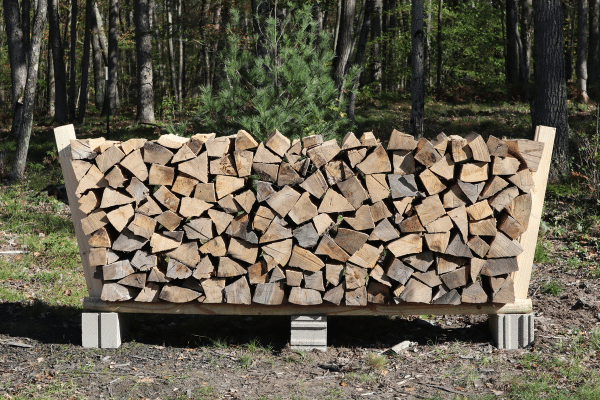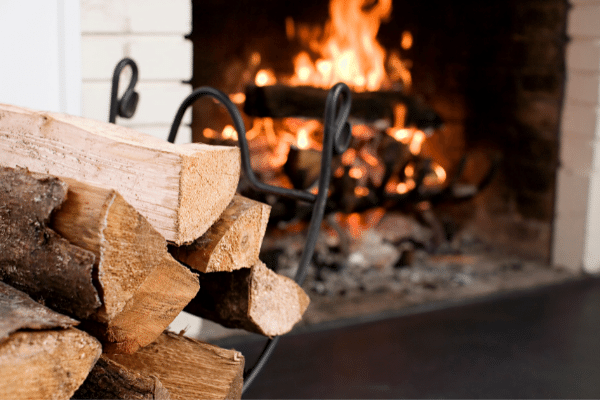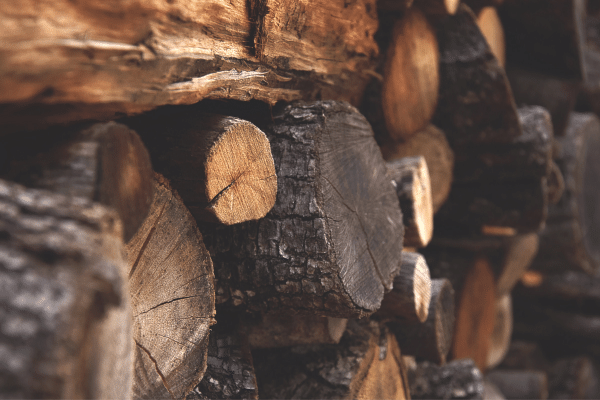- Home
- Types Of Firewood
- Cord of Firewood
Cord Of Firewood
This post may contain affiliate links so I earn a commission.
People ask me all the time, “You got a cord of firewood? How long will that last you?”
It’s a legitimate question, yet it is unanswerable.
If the question comes from a non-wood burner who is just making small talk, I usually answer with a vague “about eight to twelve weeks, depending.”
But if the person seems to want a concrete answer, is a novice wood burner, or is interested in the science of wood burning, I'm happy to launch into a full-on discussion on the topic.
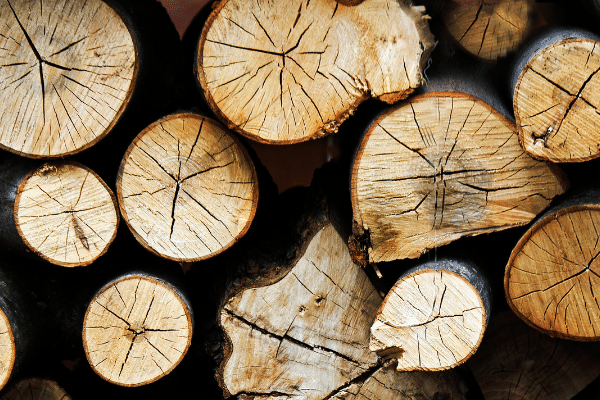
Still, I can't offer a solid answer.
There are simply too many factors in play that can alter the burning time of a cord of wood.
With a cord of wood, it’s not about the quantity.
It’s more about the quality.
How Much Wood Is In A Cord?
Before we discuss the factors that impact the burn time of a cord of wood, it is important to understand how much wood is in a cord.
By legal definition (yes, legal), a cord of wood is a tightly stacked unit of firewood that is four feet tall, four feet wide, and eight feet long.
This configuration takes up 128 cubic feet.
It looks like a lot of wood so you may think to yourself, “yep, that should last me a while”, but exactly how long depends on a number of variables.
What's The Best Type Of Firewood To Burn?
One of the biggest factors in determining how long a cord of wood will last is the species of tree that makes up the firewood.
Not all firewood is created equal.
The organic composition of the trees differs from species to species, therefore some wood burns better than others.
When purchasing a cord of firewood, the first question you should ask is what kind of wood it is.
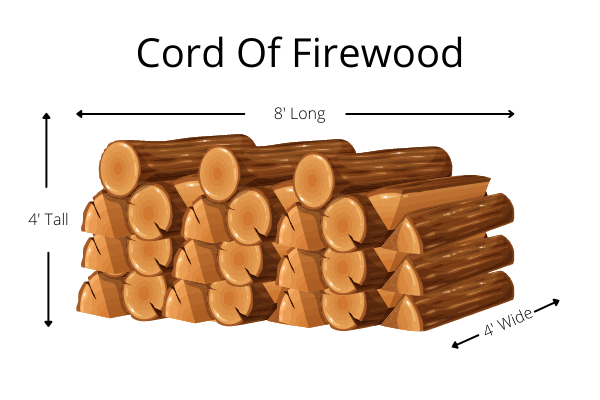
You will naturally want firewood
with the highest BTUs so you can get more heat from your cord of wood.
A BTU, or British Thermal Unit, measures the heat value in a combustible material, like firewood.
The higher the BTUs, the more heat the wood will produce.
Oak, ash, Osage orange, hickory, and black walnut are among North American trees with the highest BTUs.
Firewood with low BTUs includes cottonwood, willow, cedar, aspen, and buckeye.
You will get more bang for your buck – and more heat from your cord of wood – if you burn a species with a higher BTU.
Moisture Content In Firewood
The second most important factor to consider when trying to find out how long a cord of firewood will last is the moisture content of the wood.
Wood burns more efficiently and gives off more heat when it is dry.
Ideally, you want firewood with a moisture content below 20% for optimal heat output.
You may hear folks tell you to let fresh-cut firewood sit for a year before you use it, so it gets seasoned.
That’s a good rule of thumb, but once again, there are variables that can impact the moisture content of the wood, such as how it is stacked and where it is stored.
When buying a cord of wood, be sure to inspect the wood.
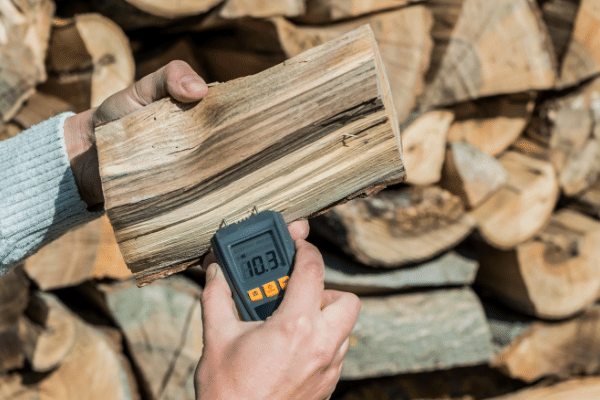
There are some ways you can
eyeball firewood to see if it is seasoned.
First, look at the color of the wood.
If there is a hint of green, the wood is still too wet.
It should be brownish gray in color.
Feel the wood.
Firewood with a high moisture content will have a smoother texture.
Once the wood has been properly seasoned, it will be rougher and more splinter-y.
Pick up a piece of the firewood.
A heavier piece of wood means there is still too much water content in the fibers.
A dry piece of wood will not be as heavy.
You can get a more accurate understanding of how dry the firewood is by using a moisture meter.

Moisture meters are available on Amazon for less than $30.
It is a small device, roughly the size of your cell phone that measures the moisture content of firewood.
Some moisture meters have two needle-like points coming out of the top.
You just stick the points into the wood and watch the digital display to give you a read out.
It is even possible to find moisture readers without the metal points…you just have to press the device up against the wood.
For folks that rely on wood heat, whether they cut their own firewood or purchase cords of wood, should consider getting a moisture meter to enhance their wood burning.
Outdoor Wood Boiler, Wood Stove Or Fireplace?
How long a cord of wood lasts also depends on where you are burning it.
A fireplace, however charming and romantic, is not an efficient way to heat a home.
Fireplaces are too open and much of the heat is lost up the chimney.
Wood burning stoves burn wood more thoroughly and produce more heat.
An outdoor wood burning furnace or boiler is even more efficient.
What that means is you will burn through your cord of wood quicker if you are using a fireplace, but it will last longer if you burn it in a wood stove.
The Size Of Your House
The size of your house – the amount of space you need to heat – will also be a factor in determining how long a cord of wood will last.
A cozy cabin will warm up quicker than a spacious, open home.
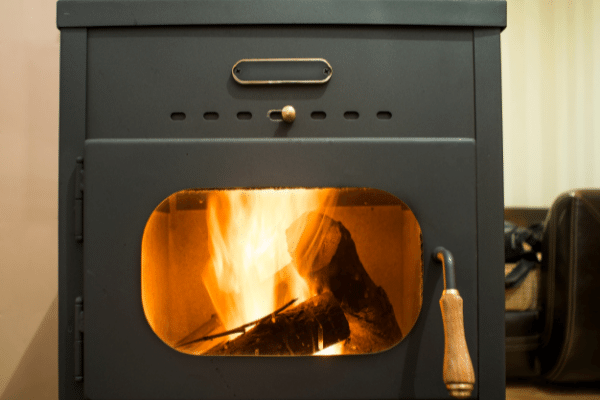
Naturally,
there are a few other factors that also play into this, such as the age of the
home, the amount of insulation, the number of windows and doors, the height of
the ceiling, and more.
Someone with a modest, two-bedroom ranch house will not burn through their cord of firewood as fast as a family living in a four-bedroom, two-story home with vaulted ceilings.
The Weather And Firewood Usage
You will burn through your cord of firewood quicker when the mercury dips low and you need to keep your family warm.
But in milder weather, you obviously won’t burn as much.
How long a cord of wood lasts you will be different in October than it will be in January.
Cord Of Firewood - Overall
So, let’s add it all up.
To make a cord of firewood last the longest, you need to have species of wood with a high BTU.
That wood must be well seasoned with a moisture content below 20%.
You would, ideally be burning it in a EPA certified wood stove in mild weather to heat a small-ish, well-insulated home.
If some of these factors don’t apply to you, you should expect your cord of firewood to be depleted quicker.
Just how much quicker.…well, that is a question that is still unanswerable.
